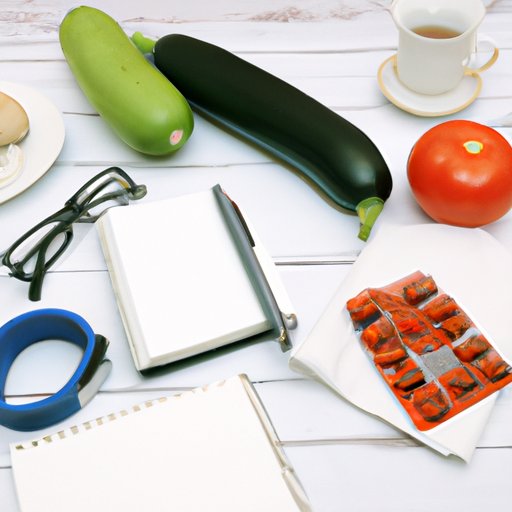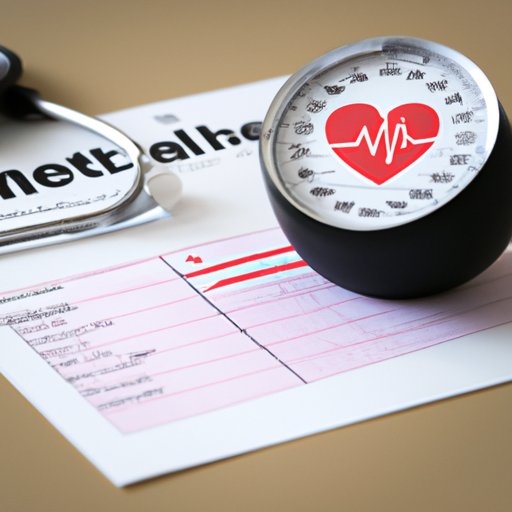
Introduction
Low blood pressure, also known as hypotension, occurs when the pressure of the blood flowing through your arteries drops below the normal level, putting you at risk for dizziness, fainting, fatigue, and other health issues. While low blood pressure is not as common as high blood pressure, it can be just as serious and debilitating for those who suffer from it.
In this article, we will explore 7 natural remedies to boost low blood pressure, offer simple lifestyle changes to manage it, discuss foods that help raise low blood pressure, and outline the surprising benefits of exercise in regulating blood pressure. We’ll also offer insights into herbal supplements and other tips to manage low blood pressure without medication and stress the importance of staying hydrated to combat hypotension.
7 Natural Remedies to Boost Low Blood Pressure
Here are 7 natural remedies to help boost low blood pressure:
Deep breathing techniques
Deep breathing techniques can help increase blood flow and improve circulation, addressing low blood pressure and promoting overall relaxation and well-being. Diaphragmatic breathing involves taking slow, deep breaths from the diaphragm, rather than the chest. Simply inhale deeply, expanding your abdomen, hold for a few seconds, and exhale slowly and completely. Repeat for a few minutes several times per day.
Drink water and stay hydrated
Drinking plenty of fluids is essential to maintain adequate blood pressure levels when suffering from low blood pressure. Aim for at least 8-10 glasses of water per day, and avoid alcohol and caffeinated beverages, which can increase fluid loss and worsen dehydration. Herbal teas and fruit juices can be healthy substitutes.
Add salt to your diet
Salt can increase blood pressure effectively, particularly in otherwise healthy people suffering from hypotension. Try adding a pinch of salt to your meals, indulging in salty snacks like chips and pretzels, or consuming salted beverages like broth or tomato juice.
Eat small, frequent meals
Low blood pressure can cause dizziness and fatigue, particularly after meals. To counter this effect, avoid large, heavy meals and instead eat several light, nutritious meals throughout the day. This can help keep your blood sugar levels stable and your energy levels up.
Increase caffeine consumption
Caffeine is a well-known stimulant that increases heart rate and can help raise blood pressure. While it’s important to exercise caution, as too much caffeine can cause other health issues, drinking a few cups of coffee or tea in the morning or throughout the day can be a healthy way to boost your energy and blood pressure levels. Consult with your doctor to determine the optimal level of caffeine intake for you.
Consume foods high in folate and vitamin B12
Folate and vitamin B12 play a crucial role in red blood cell production, which is essential for healthy blood pressure levels. Eating foods rich in these vitamins, such as leafy greens, citrus fruits, beans, eggs, meat, and dairy products, can help address low blood pressure and promote overall health.
Take ginseng supplements
Ginseng is a popular herbal supplement known for its ability to increase energy, mental focus, and blood pressure. Studies have demonstrated that ginseng extract can help increase arterial blood pressure levels effectively and safely. Consult your doctor before starting any herbal supplement regimen, as they can interact negatively with other medication or conditions.
Simple Lifestyle Changes to Manage Low Blood Pressure
Simple lifestyle changes can also be helpful in managing low blood pressure. Here are some tips:
Exercise regularly
Exercise is essential in regulating blood pressure by improving cardiovascular health. Aerobic exercise, such as walking, jogging, swimming, and cycling, can help increase blood flow and strengthen the heart while reducing stress levels. Consult with your doctor to determine the optimal exercise routine for you.
Maintain a healthy diet
A healthy diet is essential to promote overall well-being, including optimizing blood pressure. Focus on whole grains, fresh fruits, vegetables, lean proteins, and healthy fats, and avoid processed, high-fat, and high-sugar foods. Consult with your dietitian to determine the best diet plan for you.
Avoid alcohol and smoking
Alcohol and smoking can cause blood vessels to constrict, reducing blood flow and exacerbating low blood pressure symptoms. Limit or eliminate these habits from your lifestyle to improve your overall health and well-being.
Get enough sleep
Getting adequate sleep is crucial in maintaining your body’s vital functions, including blood pressure regulation. Aim for 7-8 hours of sleep every night, and establish a consistent sleep schedule to optimize your sleep quality and quantity.
Reduce stress levels
Stress can interfere with your body’s ability to regulate blood pressure effectively, making relaxation techniques like yoga, meditation, and mindfulness especially beneficial. Take steps to minimize stress in your life and prioritize self-care.
Avoid standing for long periods of time
Standing for long periods of time can cause blood to pool in the legs, reducing blood flow to the brain and other organs. If you must stand for extended periods of time, wear compression stockings or engage in light foot exercises to promote blood flow.
Monitor your blood pressure regularly
Monitor your blood pressure regularly to keep track of your progress and make any necessary modifications to your lifestyle or treatment plan.
Foods That Help Raise Low Blood Pressure
The following foods can help raise low blood pressure:
Salty snacks and foods
Salty snacks like chips and pretzels, as mentioned, can help raise blood pressure levels effectively. In moderation, salty foods can be an easy and tasty way to regulate your hypotension.
Milk and dairy products
Milk and dairy products are high in nutrients that benefit overall health and improve blood pressure. Low-fat yogurt, cheese, and milk can be an excellent addition to your diet.
Beetroot juice
Beetroot juice has been shown to improve blood pressure levels effectively. This vegetable is naturally high in nitrates, which convert to nitric oxide in the body, widening blood vessels and reducing blood flow resistance.
Licorice root
Licorice root contains compounds that can help regulate blood pressure, but it should be consumed in moderation, as excess consumption can lead to health complications.
Dark chocolate
Dark chocolate contains flavanols that have been shown to improve blood flow and lower overall blood pressure levels safely and effectively. Indulging in a daily serving of dark chocolate can be a delicious and healthy habit.
Raisins
Raisins are an excellent source of nutrients that promote cardiovascular health and regulate blood pressure. They are also high in natural sugars, so consume them in moderation.
Pomegranate juice
Pomegranate juice is high in antioxidants and nutrients that promote healthy blood flow and prevent inflammation, making it an excellent drink to include in your diet if you suffer from low blood pressure.

The Surprising Benefits of Exercise for Low Blood Pressure
Exercise is an excellent way to improve cardiovascular health and regulate blood pressure. Here are some of the benefits of exercising to improve low blood pressure:
Explanation of how exercise affects blood pressure
Exercise helps regulate blood pressure by improving cardiovascular health and increasing the heart’s ability to pump blood efficiently.
Types of exercises that are beneficial
Aerobic exercise like brisk walking, jogging, cycling, and swimming are beneficial in regulating blood pressure. Resistance training and weight lifting are also effective ways to increase muscle mass and improve circulation.
Recommended duration and frequency of exercise
Health professionals recommend exercising for 30-60 minutes per day, five days per week to improve cardiovascular health and regulate blood pressure effectively. However, even a few minutes of light exercise can have positive effects.
Precautions to take when exercising with low blood pressure
If you have low blood pressure, it’s essential to exercise caution when starting a new exercise program. Start slowly and consult with your doctor before beginning any exercise routine. Avoid high-intensity exercises and exercises where you’re required to stand for extended periods, and drink fluids regularly to stay hydrated.
Success stories of patients who have benefited from exercising
Many patients have shown significant improvements in their low blood pressure symptoms after engaging in regular exercise routines, such as walking or water aerobics. Consult with your doctor to determine the best exercise plan for you and begin reaping the benefits of regular exercise today.
Herbal Supplements to Consider for Low Blood Pressure
Many herbal supplements have been shown to improve blood pressure levels safely and effectively. Here are some of the most effective:
Hawthorn
Hawthorn has been used in traditional medicine for centuries and has been shown to improve blood pressure levels by dilating blood vessels and improving blood flow. It’s a safe herb with few side effects.
Garlic
Garlic contains allicin, a compound that can improve circulation and lower blood pressure levels safely and effectively. Garlic is available in supplements or can be added to your diet easily.
Flaxseed
Flaxseed is high in omega-3 fatty acids, which have been shown to promote heart health and lower blood pressure levels. Flaxseed oil supplements or flaxseed meal can be added to your diet easily.
Ginger
Ginger has been shown to have anti-inflammatory properties that can reduce blood pressure levels and improve overall health. It’s commonly consumed as tea or can be added to food as a spice.
Holy basil
Holy basil is a medicinal herb used in Ayurvedic medicine to regulate blood pressure levels and promote overall health. This herb can be consumed as tea or added to food as a spice.
Cinnamon
Cinnamon has been shown to regulate blood sugar levels and improve blood pressure levels in people with diabetes. Add cinnamon to food or beverages throughout the day to reap its benefits.
Fish oil
Fish oil is high in omega-3 fatty acids and can improve overall heart health and blood pressure levels. Take fish oil supplements or consume oily fish like salmon or mackerel regularly to reap its benefits.
7 Tips for Managing Low Blood Pressure Without Medication
If you want to manage low blood pressure without medication, here are seven tips:
Increase salt and fluid intake
As previously noted, salt can be effective in raising blood pressure levels in hypotensive people. Likewise, increasing fluid intake can help combat dehydration and elevate blood pressure levels.
Wear compression stockings
Compression stockings can help promote blood flow and prevent pooling of blood in the legs, particularly helpful in those who suffer from hypotension.
Avoid standing in one place for too long
As previously noted, standing in one place for too long can cause blood to pool in the legs, reducing blood flow to vital organs. If you must stand for extended periods, move around frequently or shift your weight from one foot to another to promote blood flow.
Use the head of your bed to elevate your feet while sleeping
Elevating your feet while sleeping can help promote blood flow and prevent pooling of blood in the legs, reducing the risk of dizziness and fainting upon standing.





